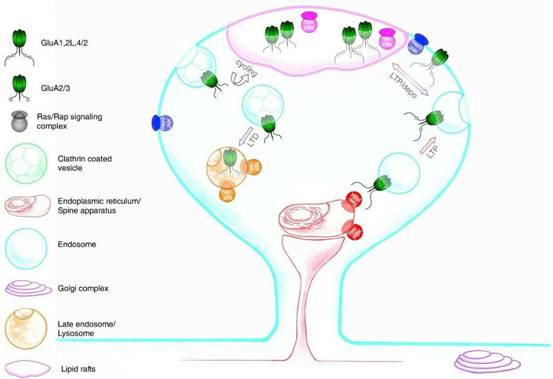Written by: Qi Xiaoquan
Translated by: Shen Xiao
Date: 2018-8-6
Wang Guangfu research group of the Life Science Centre has made important progress in regulating synaptic plasticity through Ras and Rap signaling pathways. The paper "Ras and Rap Signal Bidirectional Synaptic Plasticity via Distinct Subcellular Microdomains" was published in the well-known neuroscience journal Neuron (Neuron, impact factor 14.318). Researcher Wang Guangfu is the co-author of this paper.
Synapse is the place where neurons form connections, and synaptic plasticity is the ability to enhance and weaken synaptic connections. Synaptic plasticity has different forms in learning and memory, including long-term potentiation, depotentiation and long-term depression. Previous studies have confirmed that Ras family small GTP enzymes (i.e. Ras, Rap2 and Rap1) can act as molecular switches in multiple signal transduction cascades to control these different forms of synaptic plasticity respectively. However, Ras and Rap proteins are highly homologous in sequence and structure, and can be activated by the same upstream signal or the same downstream effector. Therefore, the problem of how signal molecules achieve signal diversity and specificity, which has long existed in cell biology, has been raised again.
Ras or Rap proteins were specifically expressed in the endoplasmic reticulum, lipid rafts, main membranes, lysosomes or Golgi apparatus by targeting delivery methods. Then, using high-resolution patch clamp recording, Wang Guangfu and colleagues found that Ras activated the long term potentiation signal pathway via endoplasmic reticulum and lipid rafts, while Rap2 and Rap1 activated the depotentiation and long term depression signal pathway through the main membrane and lysosome, respectively. This study not only reveals the diversity and specificity of signal molecules through different signal transduction platforms in different subcellular structures, but also provides an accurate regulatory tool and an effective research strategy to promote the development of precise targeted drugs to treat various diseases.

Researcher Wang Guangfu has long been engaged in the field of neural circuits and synaptic plasticity, and has focused on the development and application of biological photonics. In addition to this paper, his research on acetylcholine fluorescence probes was published recently in the journal Natural Biotechnology, (Nature Biotechnology, impact factor 35.724). Acetylcholine is an important neurotransmitter associated with learning and memory, Alzheimer's disease and so on. It is expected that the publication of the paper will promote a deeper understanding of acetylcholine.
Wang Guangfu, a researcher who received a doctorate from Peking University in 2008 and a postdoctoral study at the University of Virginia in the United States from 2008 to 2017, joined the Life Science Centre of HIT full-time in December 2017. He focuses on the study of cortical neuronal circuits and synaptic plasticity related to neuropathy. The reserch results are published in top international journals such as Genes & development, Nature Neuroscience, Nature Protocols, Neuron, Cerebral Cortex, and The Journal of Neuroscience.


